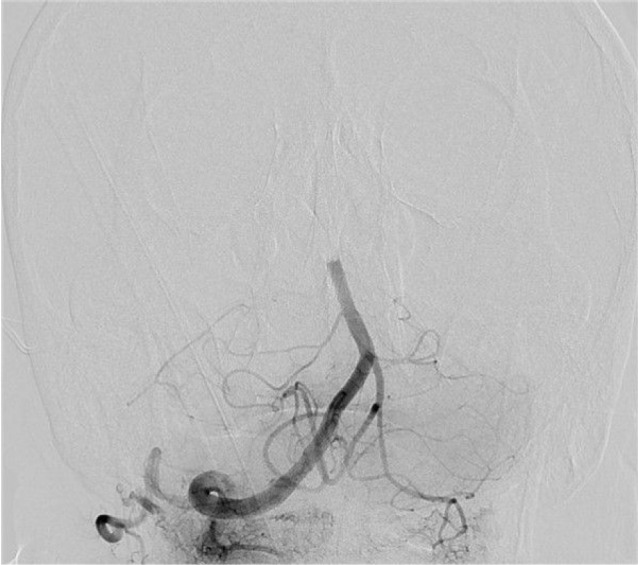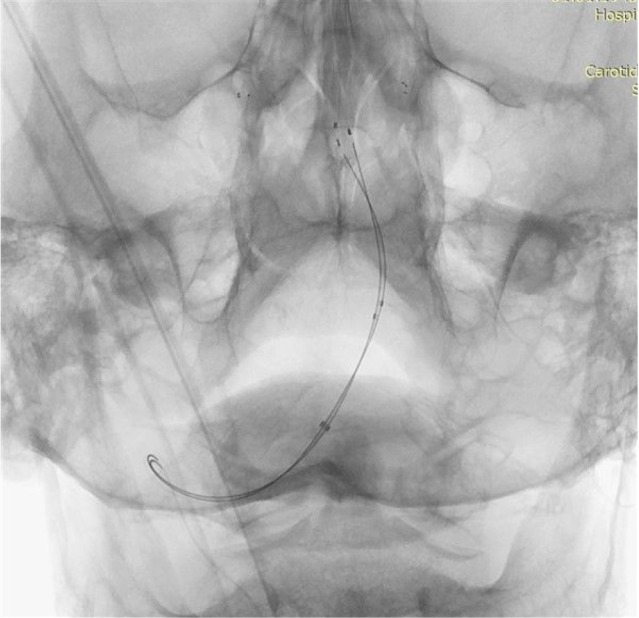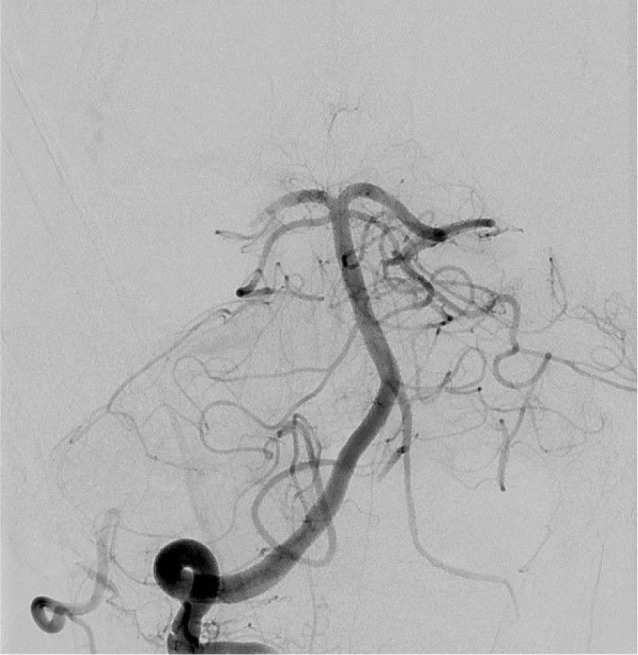J Cerebrovasc Endovasc Neurosurg.
2017 Jun;19(2):96-100. 10.7461/jcen.2017.19.2.96.
Dual Mechanical Thrombectomy for Recanalization of a Resistant Acute Posterior Circulation Stroke
- Affiliations
-
- 1Department of Radiology, Faculty of Medicine, Hacettepe University, Ankara, Turkey. anilarat@hotmail.com
- 2Department of Neurology, Faculty of Medicine, Hacettepe University, Ankara, Turkey.
- KMID: 2393386
- DOI: http://doi.org/10.7461/jcen.2017.19.2.96
Abstract
- A 71-year-old man with acute basilar artery occlusion was referred for endovascular treatment 6 hours after the onset of stroke with a Glasgow Coma Score of 3 and National Institutes of Health Stroke Scale of 27. A cerebral arteriogram revealed occlusion of the left vertebral artery proximally and thromboembolic occlusion of the basilar tip. Direct aspiration and mechanical thrombectomy with various stent retrievers failed to reconstitute arterial flow in the basilar artery. Thrombolysis in cerebral infarction 2b recanalization was achieved only after placement of double Catch Mini stent retrievers through 2 microcatheters, on both side branches of the basilar bifurcation in a kissing fashion and retrieving them simultaneously. It was possible to perform this maneuver through a single distal access catheter without any complications. On follow-up the patient awakened and was able to follow commands on his right side. To our knowledge, dual mechanical thrombectomy with stent retrievers has not been reported in the posterior circulation previously. This technique may be useful in retrieving thrombi located at major intracranial bifurcations of the posterior circulation which do not recanalize with standard mechanical thrombectomy procedures. Although bilateral access to the basilar artery through both vertebral arteries is an advantage in posterior circulation for this technique, dual mechanical thrombectomy can also be performed through a unilateral access.
Keyword
MeSH Terms
Figure
Reference
-
1. Clarençon F, Blanc R, Gallas S, Hosseini H, Gaston A. Thrombectomy for acute basilar artery occlusion by using double Merci retriever devices and bilateral temporary vertebral artery flow reversal. Technical note. J Neurosurg. 2009; 7. 111(1):53–56. PMID: 19249927.2. Ding D. Intravenous versus intra-arterial thrombolysis for acute ischemic stroke secondary to basilar artery occlusion. J Cerebrovasc Endovasc Neurosurg. 2014; 3. 16(1):39–41. PMID: 24765612.
Article3. John S, Hussain MS, Toth G, Bain M, Uchino K, Hui FK. Initial experience using the 5MAX™ ACE reperfusion catheter in intra-arterial therapy for acute ischemic stroke. J Cerebrovasc Endovasc Neurosurg. 2014; 12. 16(4):350–357. PMID: 25599043.
Article4. Kim TK, Rhim JK, Lee CJ, Oh SH, Chung BS. The limitations of thrombectomy with Solitaire™ AB as first-line treatment in acute ischemic stroke: A single center experience. J Cerebrovasc Endovasc Neurosurg. 2012; 9. 14(3):203–209. PMID: 23210048.
Article5. Klisch J, Synchra V, Strasilla C, Taschner CA, Reinhard M, Urbach H, et al. Double solitaire mechanical thrombectomy in acute stroke: effective rescue strategy for refractory artery occlusions? AJNR Am J Neuroradiol. 2015; 3. 36(3):552–556. PMID: 25324495.
Article6. Park H. A suction thrombectomy technique: a rapid and effective method for intra-arterial thrombolysis. J Cerebrovasc Endovasc Neurosurg. 2015; 3. 17(1):13–19. PMID: 25874180.
Article7. Powers WJ, Derdeyn CP, Biller J, Coffey CS, Hoh BL, Jauch EC, et al. 2015 American Heart Association/American Stroke Association Focused Update of the 2013 Guidelines for the Early Management of Patients With Acute Ischemic Stroke Regarding Endovascular Treatment A Guideline for Healthcare Professionals From the American Heart Association/American Stroke Association. Stroke. 2015; 10. 46(10):3020–3035. PMID: 26123479.
Article8. Singer OC, Berkefeld J, Nolte CH, Bohner G, Haring HP, Trenkler J, et al. Mechanical recanalization in basilar artery occlusion: the ENDOSTROKE study. Ann Neurol. 2015; 3. 77(3):415–424. PMID: 25516154.
Article9. Yoo DS. Recanalization rate after intravenous tissue plasminogen activator administration. J Korean Soc Intravasc Neurosurg. 2009; 4(1):12–16.
- Full Text Links
- Actions
-
Cited
- CITED
-
- Close
- Share
- Similar articles
-
- Implications of Mechanical Endovascular Thrombectomy for Acute Basilar and Posterior Cerebral Artery Occlusion
- Recurrent Cardioembolic Stroke Treated Successfully with Repeated Mechanical Thrombectomy within the Acute Index Stroke Period
- Forced Arterial Suction Thrombectomy Using Distal Access Catheter in Acute Ischemic Stroke
- Safety and Efficacy of Mechanical Thrombectomy with Solitaire Stent Retrieval for Acute Ischemic Stroke: A Systematic Review
- Paradigm Shift in Intra-Arterial Mechanical Thrombectomy for Acute Ischemic Stroke : A Review of Randomized Controlled Trials after 2015





